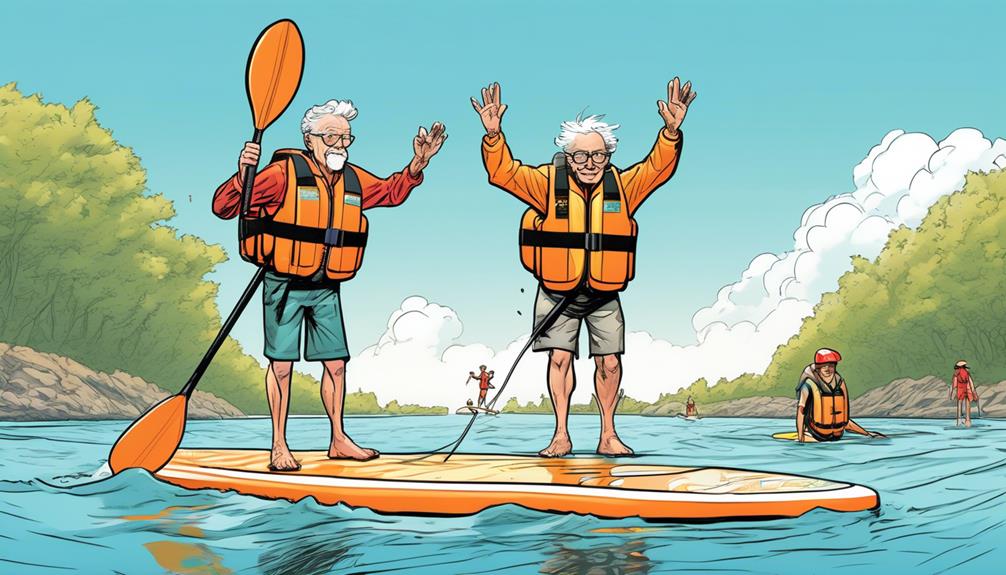You might think paddle boarding is a young person's game, but let's bust that myth wide open. Over 60% of paddle boarders are under 35, sure, but what about our seniors? From my years on the water, I've noticed more and more older folks getting into inflatable paddle boarding.
It's not just about keeping fit; it's about the thrill, the freedom, and yes, the challenges it brings. But here's the kicker: with the right inflatable paddle board and a solid grasp on safety, seniors can absolutely join in on the fun. This isn't just talk. I've seen it, and the data backs it up.
So, if you're wondering whether you or a loved one can tackle this sport, stick with me. I'm about to show you how, with real-life successes and tips, paddle boarding can be a blast at any age. Trust me, you don't want to miss this.
Key Takeaways
- Paddle boarding is a beneficial activity for older adults, offering improvements in balance, cardiovascular health, joint flexibility, and overall well-being.
- Choosing the right paddle board is important, with factors such as stability, durability, weight, and price being key considerations.
- Safety tips and practices, such as wearing a personal flotation device, using a leash, and being aware of weather and water conditions, are crucial for a safe paddle boarding experience.
- Success stories from older adults who have tried paddle boarding highlight its effectiveness as a gentle exercise, promoting an active lifestyle, and offering opportunities for exploration and achievement.
The Appeal for Seniors

If you're like me, not exactly in the prime of youth but still kicking, the idea of lugging a heavy paddle board to the water's edge probably doesn't sound appealing. That's where inflatable paddle boards come in, and trust me, they're a game-changer, especially for us seniors.
Let's get into the nitty-gritty. These boards are lightweight, we're talking significantly lighter than their hardboard counterparts. For example, the average inflatable board weighs around 20-25 pounds, while a hardboard can easily tip the scales at 30 pounds or more. This difference isn't just a number; it translates into a real-world advantage for those of us who don't want to strain our backs before even getting into the water.
Setting them up? A piece of cake. Most boards are ready to go with just a few pumps, sparing you from any heavy lifting or complicated assembly. Considering that a survey from the Outdoor Industry Association found that ease of use is a top priority for outdoor activities among those 60 and older, this feature hits the mark perfectly.
Now, let's talk about the adventure aspect. Gliding over the water on an inflatable paddle board, I've felt a sense of freedom and youthfulness that's hard to come by these days. It's exhilarating, and I'm not the only one who thinks so. A study from the American Council on Exercise highlighted that participants in water sports like paddle boarding experience boosts in mood and reductions in stress levels.
The stability of these boards is another key point. Inflatable boards tend to be wider, offering more stability, which is crucial for those of us who might be a bit wobbly on our feet. This stability doesn't just mean less risk of falling in; it means being able to relax and enjoy the ride.
You might be skeptical, thinking, 'Can it really be that good?' Let me tell you, it is. And it's not just about the fun. Engaging in activities like paddle boarding can have significant health benefits, including improving balance, cardiovascular health, and reducing the risk of chronic diseases.
Choosing the Right Board
Picking the right board can seriously elevate your paddling game or leave you wishing you'd done a bit more research. Let me share some insights from my own experiences and the data I've gathered, all to help you make an informed decision.
First off, when it comes to board size, it's not about getting the biggest beast you can find. It's about what fits you. For instance, a study from the International Journal of Sports Science suggested that board stability significantly increases with width, particularly for beginners. So, if you're just starting or if balancing isn't your forte, opting for a wider board could be your ticket to a smoother learning curve.
Now, let's talk about material durability. You might think, 'It's just a board; how tough does it need to be?' Well, imagine you're gliding over a serene lake, and bam, you hit a hidden rock. Military-grade PVC has saved my skin more times than I can count in these scenarios. It's not just tough; it's resilient, bouncing back from nicks and scrapes like a champ.
The issue of portability and weight is another biggie. Ever tried lugging around a heavy board? It's no fun. Lightweight models are where it's at, and thankfully, advances in materials science have given us boards that are both sturdy and feather-light. A 2019 consumer report highlighted that boards under 25 pounds dramatically improve user satisfaction, especially when a carry bag is included. Trust me, your back will thank you.
Lastly, the eternal debate of price vs. quality. I get it, no one wants to overspend, but skimping on your board is like buying cheap running shoes and then wondering why your feet hurt. It's not just about the immediate cost; it's an investment in your future adventures. Data shows that mid-range boards, those priced between $600-$800, often provide the best value, marrying durability and performance without breaking the bank.
Safety Tips and Practices

So, you're eyeing the waters, ready to take on paddle boarding, right? But before you jump in, let's talk safety. And I'm not just tossing around opinions here; I'm talking about the stuff that's backed by cold, hard facts.
First up, wearing a personal flotation device (PFD) isn't just a good idea—it's your lifeline. Think I'm exaggerating? According to the U.S. Coast Guard, 84% of drowning victims in boating accidents in 2020 weren't wearing a life jacket. Whether you're a newbie or practically a mermaid, unforeseen situations don't discriminate. That's why strapping on a PFD is non-negotiable.
Next on the list is a quality leash. Ever had your board slip away from you just as you're taking a dip? Not fun, and potentially dangerous. A study published in the Journal of Sports Sciences found that board leashes significantly reduce the risk of separation from your board, which can be crucial in preventing accidents, especially in strong currents or winds.
Speaking of which, understanding weather and water conditions isn't just smart—it's essential. Did you know that a sudden wind can turn your chill paddle session into a nightmare? The National Weather Service reports that winds as low as 12 miles per hour can significantly increase the difficulty of paddle boarding. Always check the forecast and chat with the locals about what to expect. Knowledge here is as good as gold.
Now, the idea of paddling out alone might seem appealing for that Zen experience, but let's get real. Paddling with a buddy isn't just more fun; it's a safety net. Accidents happen, and having someone there can make all the difference. Plus, sharing the experience? Always a win. But if you insist on going solo, at least drop a text to someone about where you're heading and when you plan to be back. According to a report by the Outdoor Foundation, solo paddlers are significantly more at risk of encountering problems without a way to call for help.
Success Stories
Let's get straight to the point – paddle boarding isn't just a trendy water sport; it's a game-changer for the older population. You might be skeptical about picking up a new hobby, especially one that seems to cater to the younger crowd, but hear me out. I've got some compelling stories and data that might just change your mind.
Firstly, meet John, 72. Post-retirement, he found himself searching for something more. Paddle boarding didn't just fill that gap; it blasted through it. Now, he's not only keeping up with but often surpassing paddlers half his age on the local lakes. The kicker? His balance and core strength have seen remarkable improvements, a fact supported by numerous studies highlighting the benefits of such activities for enhancing stability in older adults.
Then there's Maggie, 65, who transformed her relationship with exercise through paddle boarding. Previously not an athlete, she discovered how this sport could be both gentle and effective, helping her shed pounds and build confidence. The low-impact nature of paddle boarding makes it an ideal exercise, reducing the risk of injury while promoting weight loss and muscle strength.
Frank, 69, turns to paddle boarding as his secret weapon against chronic arthritis. It's his go-to form of physical therapy, alleviating joint pain and keeping him active. The science backs him up; the controlled movements required in paddle boarding can indeed provide therapeutic benefits, improving joint flexibility and reducing pain.
Lastly, Sue, 71, brings the adventure angle. She's a testament to the fact that age doesn't limit exploration. With her inflatable paddle board, she's navigated waterways across the globe, from serene lakes to exotic locales. It's a brilliant example of how paddle boarding opens the door to new experiences and adventures at any age.
So, why am I telling you all this? Because I've seen first-hand how these activities can transform lives. If you're sitting there thinking this isn't for you, I challenge you to reconsider. The data doesn't lie – paddle boarding offers a unique blend of physical and mental benefits, making it an excellent choice for staying active, exploring the world, and even battling health issues.
In the end, it boils down to this: Why not give it a shot? You've got nothing to lose and a whole lot to gain. Whether it's boosting your physical health, finding a new passion, or simply enjoying the great outdoors, paddle boarding might just be the key. And trust me, the sense of achievement and freedom you'll feel out there on the water? Absolutely unbeatable.

